Unsure about your French table manners? Click Here to download > > How to avoid these 10 food etiquette mistakes !
- Home ›
- Destinations ›
- Southern France ›
- Less-visited Luberon Villages
8 Hidden Luberon Villages (that are still authentic)
Published 11 October 2025 by Leyla Alyanak — Parisian by birth, Lyonnaise by adoption, historian by passion
The Luberon has dozens of villages scattered across its hills and valleys. Here are eight which are off the tourist path to varying degrees - all different, all sublime, all worth a visit.
Each year that goes by, the Luberon becomes more popular.
It is famous for villages like Gordes, Roussillon or Ménerbes, and with reason.
But travelers, often short on time, stick to the "best of the best" list and don't make it as far as some of the smaller, still authentic villages that have made the Luberon what it is: a sanctuary of light, lavender and stone.

I've put together a short list of some lovely villages that are either under the radar or still not too far down the trodden path. You may know a few of these, but there's every chance you'll unearth one or two you've never seen or heard of.
These are places where the Luberon still feels lived-in – bakeries that open when they feel like it, a single café doing double duty as bar and post office, or church bells that still mark the hours, with locals crowding street corners exchanging the news of the day.
This map shows you how the villages are grouped:
- You can visit Goult and Oppède-le-Vieux on the same day as Gordes or Roussillon or Lacoste.
- Ansouis and Cucuron are in the southern Luberon, easily paired with Lourmarin.
- And the northeastern villages are past Apt, so you can make a full day trip of these.
WHERE TO STAY IN THE LUBERON
- If you're driving, Bonnieux is an ideal base, with plenty of services. I stay at the Clos du Buis or if we are several, I rent an apartment, the Bonheur en Bonnieux.
- If you're not driving, Apt is the best hub for public transportation. A lovely apartment in town is Le Petit Delphia.
Core villages to explore in depth
This list starts with some of the better known but not yet overly famous villages and works its way down the list to those that are rarely visited by tourists on a schedule. To see these means you either have the luxury of time, or the spark of discovery.
1. Ansouis

Ansouis is a bit of an exception on this list: it is one of the Luberon villages actually on the list of France's most beautiful villages, but even so, it doesn't get the traffic the others do yet its charm and beauty are well worth the detour.
Ansouis is built around its château, a fortress dating back to the 10th century that was gradually transformed into a residence.
The castle is still privately owned but is one of the few in the Luberon open to the public. You'll have to reserve a guided tour if you're keen on admiring its furnished rooms and gardens, along with the stunning views across the Durance valley. The tours are in French, guided by the owner, and you won't be allowed to take photos inside, since it's lived in.
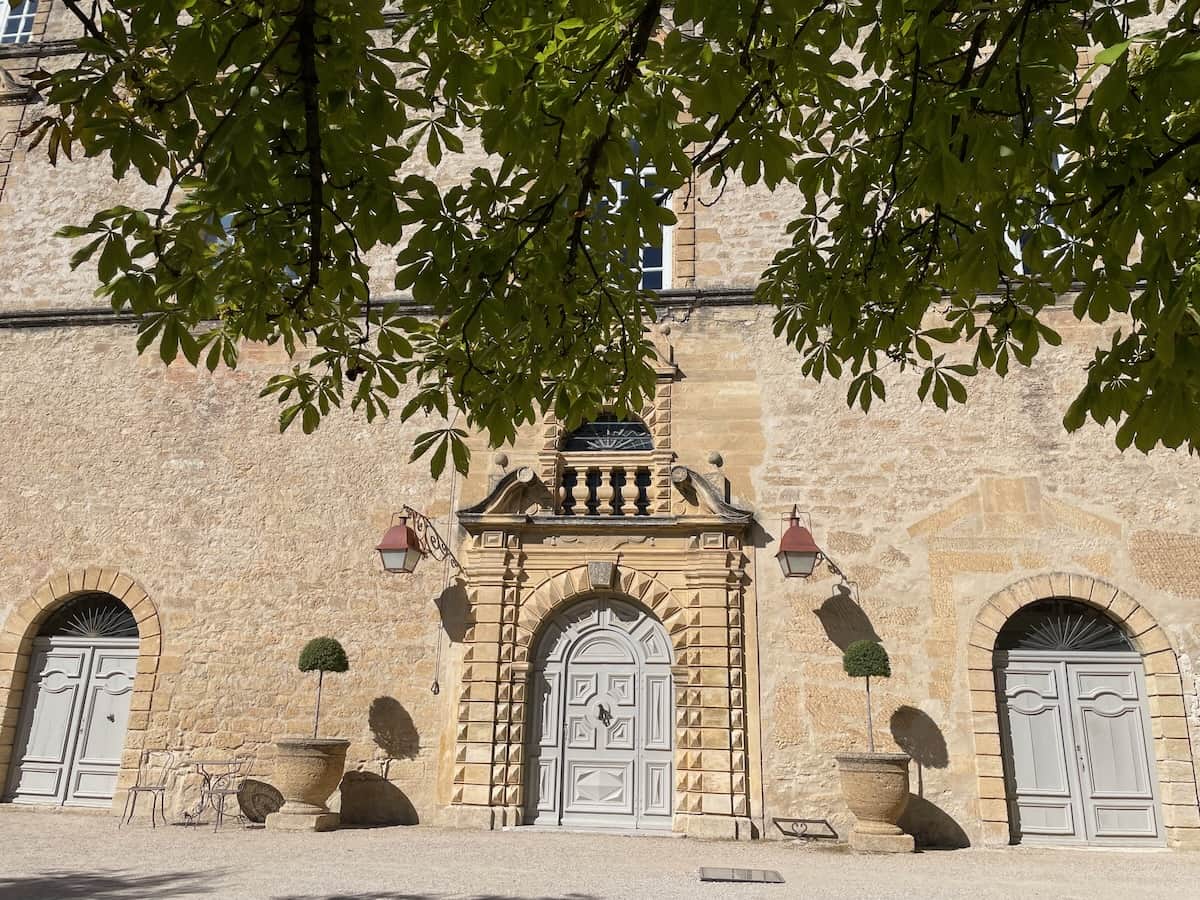
But it is unique and if you can, well worth the visit: it's actually two castles in one, with one built around its earlier medieval incarnation.
The village itself has a peaceful feel with a definite lived-in atmosphere, wrapped in silent stone, whose sound is occasionally broken by the burble of water in a nearby fountain.
Ansouis also carries a touch of celebrity: it’s where A Year in Provence author Peter Mayle often came to shop and eat. Sadly, the Michelin-starred La Closerie restaurant has closed but in its place is La Garrigue, with its several-course tasting menu. For a fabulous view from the terrace, head to the top of the village and Les Terrasses d'Ansouis.
There's also an excellent pastry shop down at the town's entrance along the main square if all you want is a slice of quiche and a pastry. Still, this is all a far cry from my last visit a few years ago, where finding a place to eat was a challenge.
Clearly this is a town to visit soon, before its reputation spreads too widely and the crowds arrive.
And if you'd like to stay nearby, Bonheur en Bonnieux makes a perfect base – it's under 20 minutes' drive and offers easy access to both Ansouis and Lourmarin.
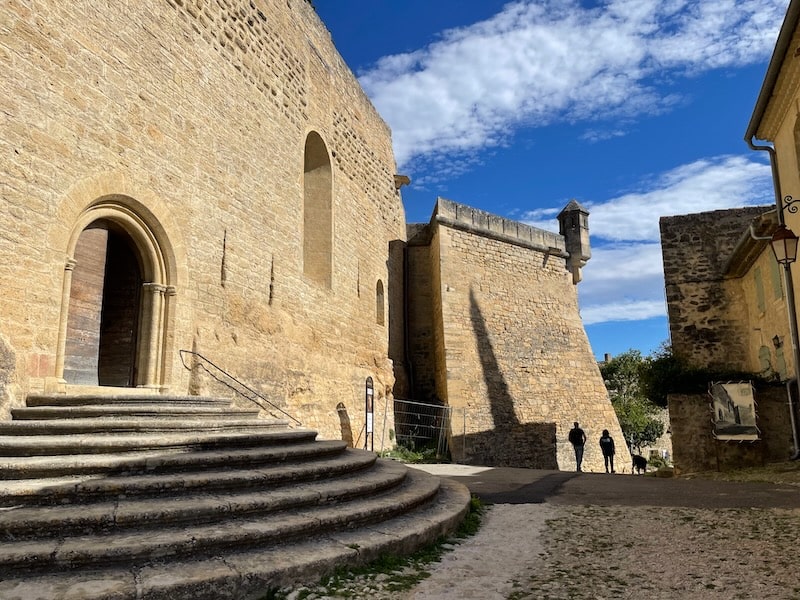
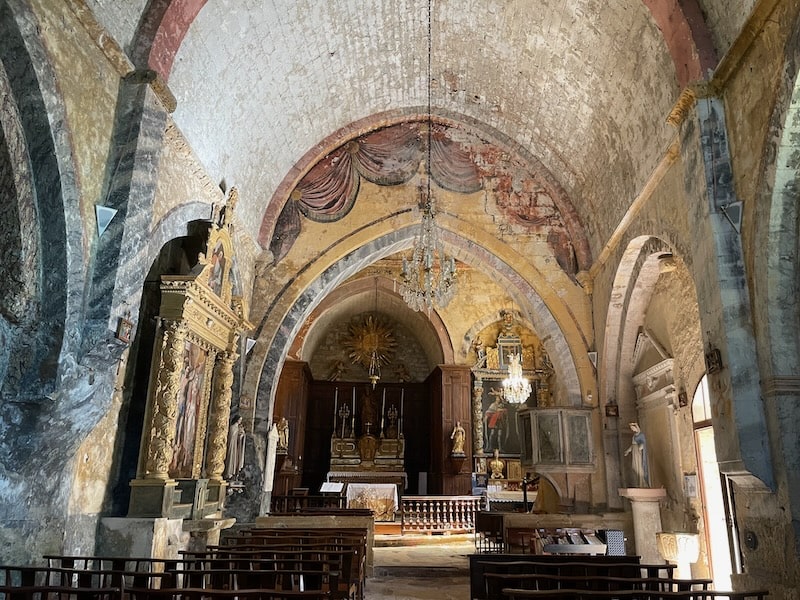
DON'T MISS THIS!
The 13th-century Church of Saint-Martin houses a carved wooden retable and a remarkable 17th-century organ, still used for concerts in summer.

2. Saignon
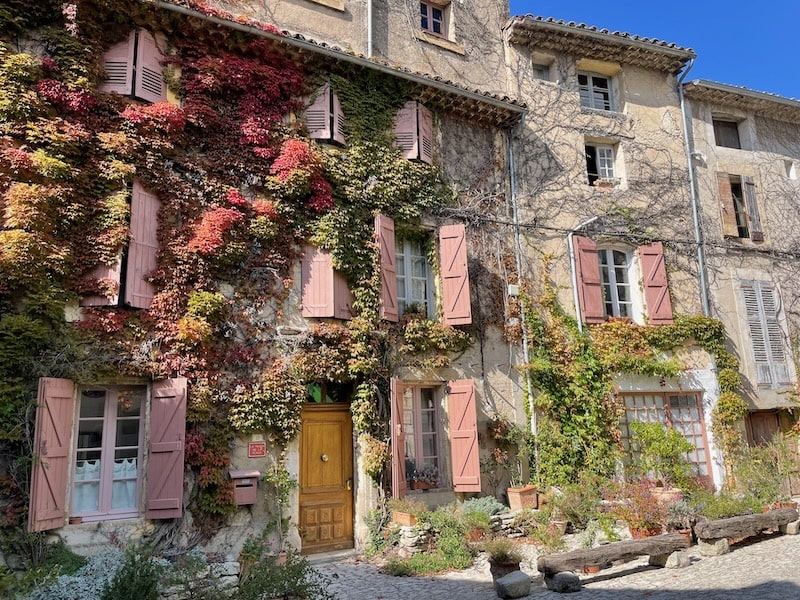
Saignon is spectacular in many ways, and the first time I visited a few years ago, it was a little rundown, charming but a bit dusty. And I fell in love.
Fast forward a few years and Saignon is becoming popular, not quite in the league of Gordes or Roussillon but definitely on the watchlist.
Saignon has everything going for it, a spectacular perch above the Calavon Valley, a 12th-century semi-Romanesque church, and a rocky outcrop tied to legend: Charlemagne’s troops are said to have assembled here before marching into Italy.

The site was already occupied in Gallo-Roman times, with villas and altars dedicated to Bacchus and Mercury. In the Middle Ages it became one of three fortified outposts defending Apt, its rocky height topped by castles and church towers.

By the 16th century, Saignon’s narrow lanes were packed inside the ramparts, the same stone passages you still walk today. The village was busy rebuilding from the Wars of Religion.

Climb to the Rocher de Bellevue at sunset, when the light hits the plain below Apt — it’s one of those places that shows you why artists never quite leave Provence. Or, sit at the foot of the church at the village's only café.
There are a very few places to eat in Saignon, but in season at least, they're open. You can choose to stay overnight in Saignon in holiday accommodations, and if you're using Apt as a hub, Le Petit Delphia apartment offers easy access to Saignon, ideal if you’re exploring without a car.
LOCAL NOTE
The bell of Notre-Dame de Pitié is rung by hand each August for the feast of the Assumption, one of the few villages in the area where the custom survives.

3. Oppède-le-Vieux - ruins with soul
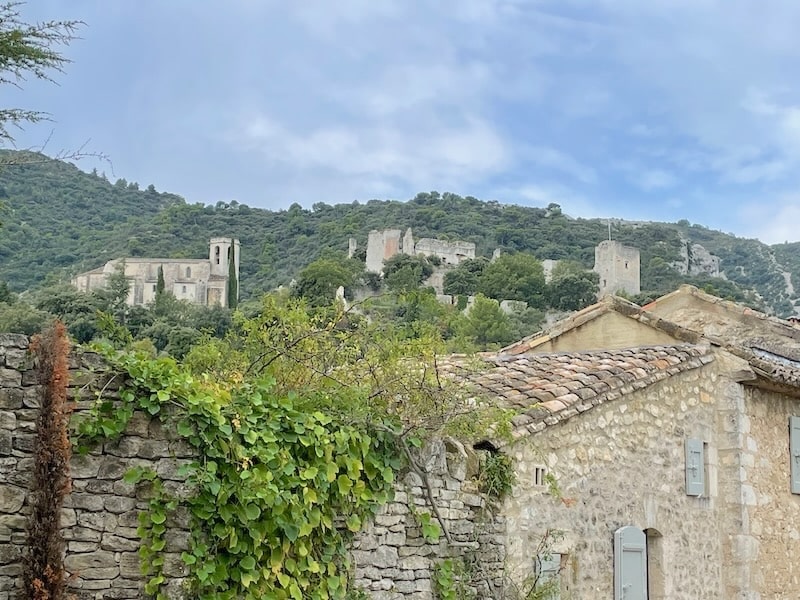
Oppède-le-Vieux is another up-and-coming village, with plenty to see – and I admit this is one of my favorite Luberon villages.
It began at the top of the hill but years of conflict, plague and landslides drove residents downhill to the newer town of Oppède, so don't confuse the two.
In the 12th century, Oppède-le-Vieux grew around a fortified castle and the church of Notre-Dame-d’Alydon, under the protection of the Maynier family. Its most notorious member, Jean Maynier, led royal troops in the 1545 massacre of the Vaudois, a Protestant community in nearby Mérindol and Cabrières.
The assault was brutal. Entire villages were razed, thousands were killed, and Oppède’s name became synonymous with repression. Maynier’s men returned home but the violence would leave an indelible stain on local memory. Centuries later, the hilltop village itself would fall victim to plague and landslides, sending its residents down to the plain.
Even if it is slowly rebuilding, you may still step through an occasional collapsed façade or crumbling arch. Even the village's castle is slowly being repaired but still too unsafe to visit.
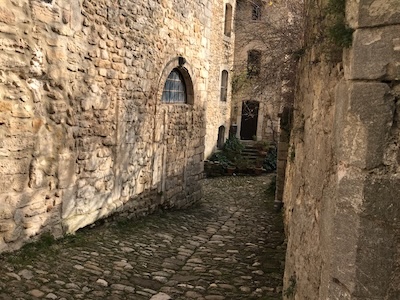
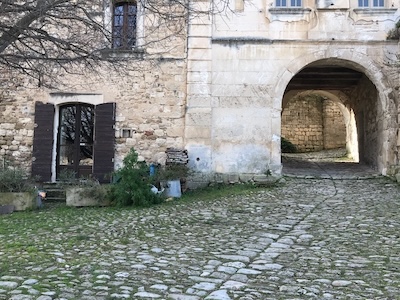
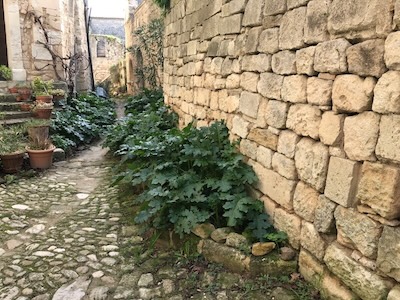
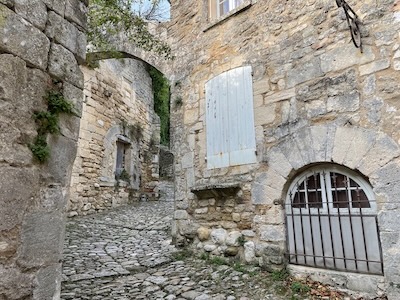
The flip side is the glorious Église Notre-Dame d’Alydon, whose simple Romanesque core has been partly restored.

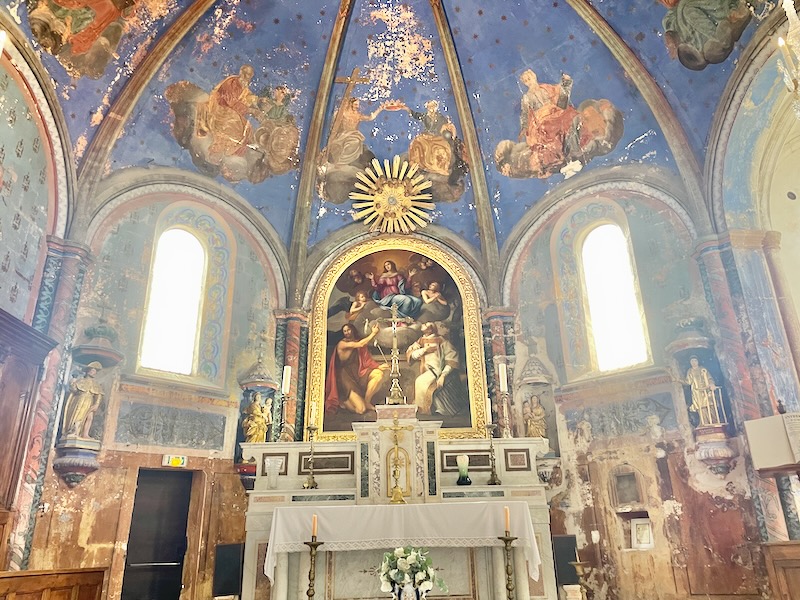
Nearly abandoned by the early 20th century, the village found new life in the 1940s, during World War II, when sculptor François de Asis and the Groupe d’Oppède (an artists' commune) began restoring its ruins. This prompted a quiet renaissance that saved it from oblivion.
Much of that artistic revival has now gone but the village remains, a certain weight of history that no renovation can erase.
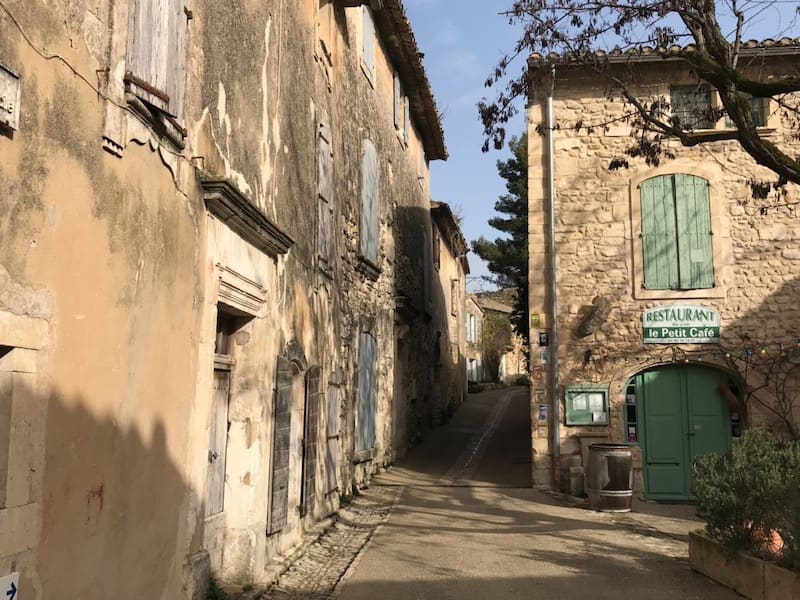
The main restaurant is Petit Café des Jeanne, right off the main square at the entrance of the village when you walk in. If you’d like to spend some time and discover this magnificent place, you can stay nearby at Clos du Buis in Bonnieux, an easy base for exploring both Oppède and Ménerbes while avoiding the crowds.

4. Goult – the Luberon’s “anti-Gordes”
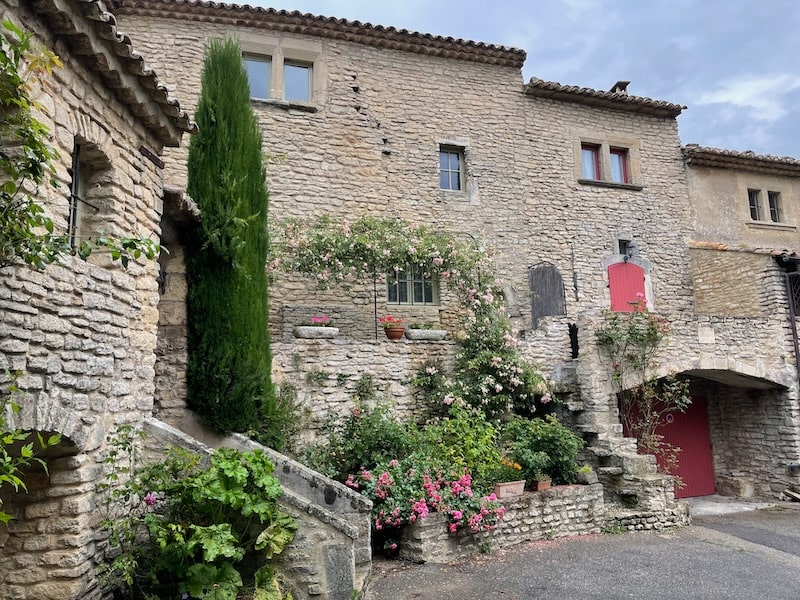
Goult is sometimes called the “anti-Gordes,” a village growing in popularity but one that has avoided the polish of its more famous neighbor.
People have lived on this rocky spur since Neolithic times, and under the Romans it was a small agricultural settlement beside the Via Domitia. In the Middle Ages, the lords of Agoult built their castle here, giving the village its name. By the 14th century, Goult’s glassmaking workshops were producing wares fine enough to earn royal protection.
In the 16th century, as the Wars of Religion swept across the Luberon, Goult sided with the Catholic cause and repelled a Protestant incursion from the nearby Valmasque valley.
Unlike Oppède-le-Vieux, whose earlier massacre of the Vaudois had foreshadowed these conflicts, Goult escaped large-scale destruction and quietly rebuilt, preserving its medieval lanes and Provençal character.

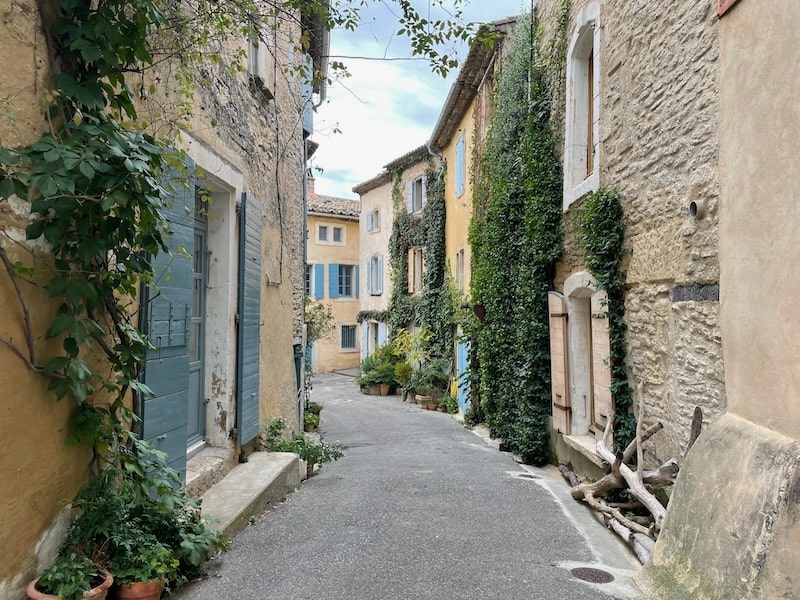

Life here centers on the church of Saint-Sébastien and the few streets around it. Along the main street, two cafés vie for business, pleasant places to watch people come and go.

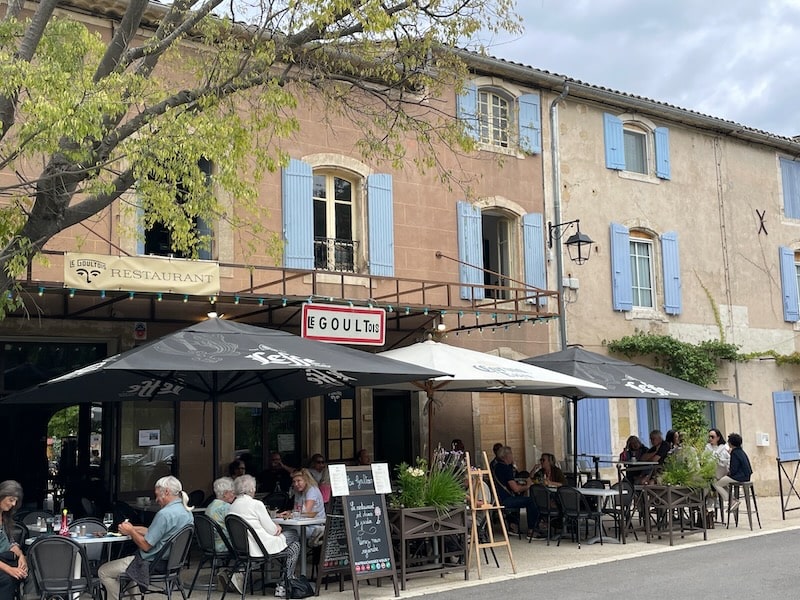
Head up the hill, past the (private) castle, along the cobblestones until you reach the restored windmill, the Moulin de Jérusalem, where grain was once milled.
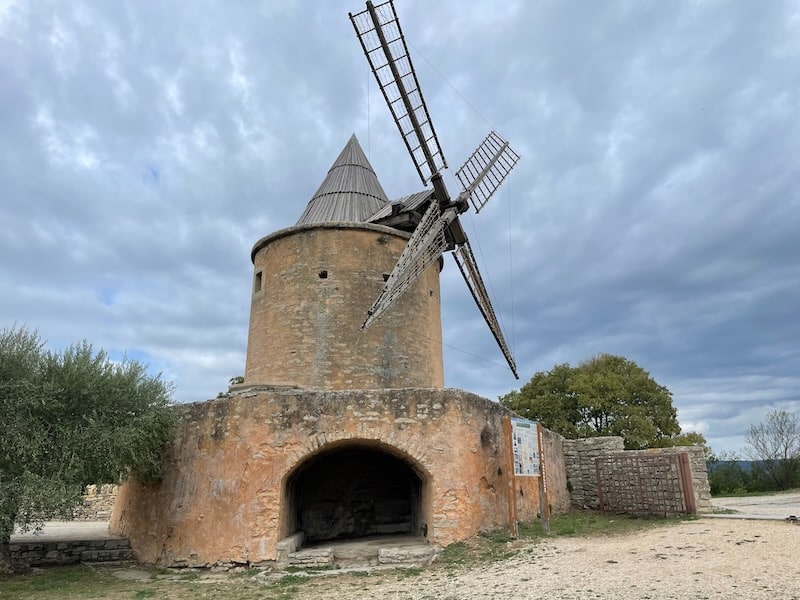
KNOCKING ON COUCOUNE'S DOOR
In Goult, even the trees have personalities, thanks to Jacques Fréjabue, known to everyone simply as Coucoune. A lifelong lover of wood, he began carving fallen trunks and dead branches decades ago, coaxing out faces, animals, and flowing forms that now stand quietly along the paths and terraces of the village. His craft runs in the family—his great-grandfather was a sawyer—and his philosophy is simple: trees and people share the same fragility.
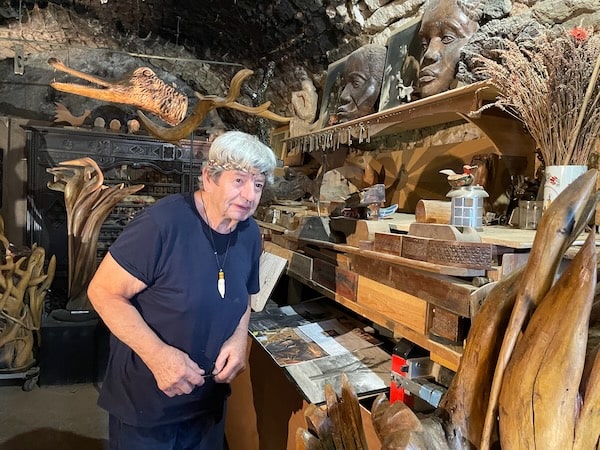
Some of his works have vanished to time or vandalism, but others remain, weathered and smiling beneath the Provençal sun, turning Goult into a small open-air gallery shaped by whimsy and affection.
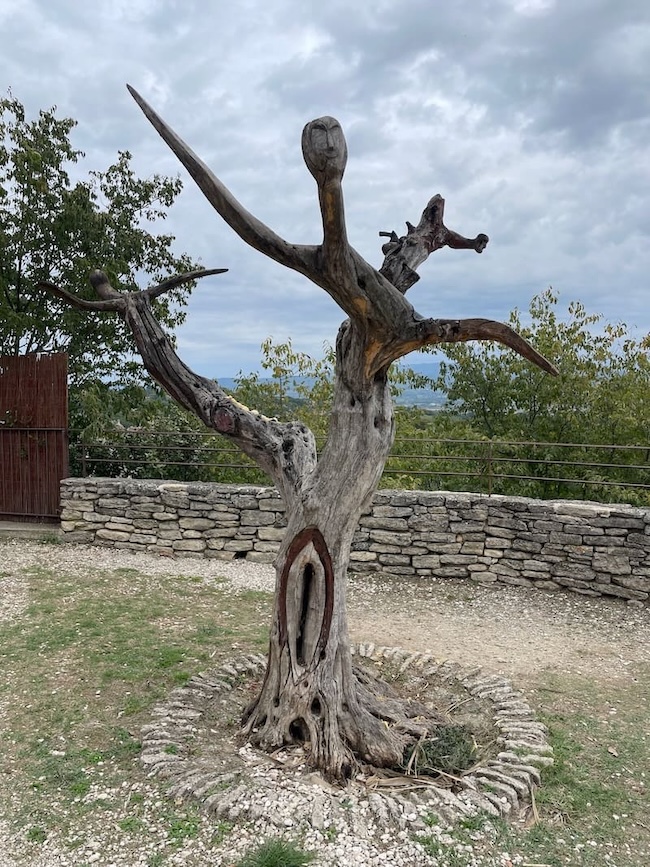
Coucoune can still be spotted working outdoors from time to time, carving with a pocketknife or shaping a fallen limb into a grin. His studio door is often open, with wood shavings on the threshold. It's how I met him.
Goult also hides small traces of its working past, like wine presses built into cellar walls, and the communal oven still used for the village fête each June.
Today, Goult remains lived-in rather than curated, a place where history still feels neighborly, from vaulted passages to old door lintels marked with masons’ symbols. It’s worth lingering for its views, the windmill, and the calm rhythm of a village that doesn't try to impress and is content to just "be".
From here, the landscape opens out toward the eastern Luberon, where things slow down and the roads gradually empty. If you don't have a car or would prefer not to drive, a good way to visit the area is by renting an electric bike; it handles the steep gradients easily and keeps parking simple.
VILLAGE WALK
Follow Rue du Four up to the windmill, then loop past Coucoune’s carvings and the terraced gardens overlooking the Calavon Valley.

5. Cucuron – life around the étang
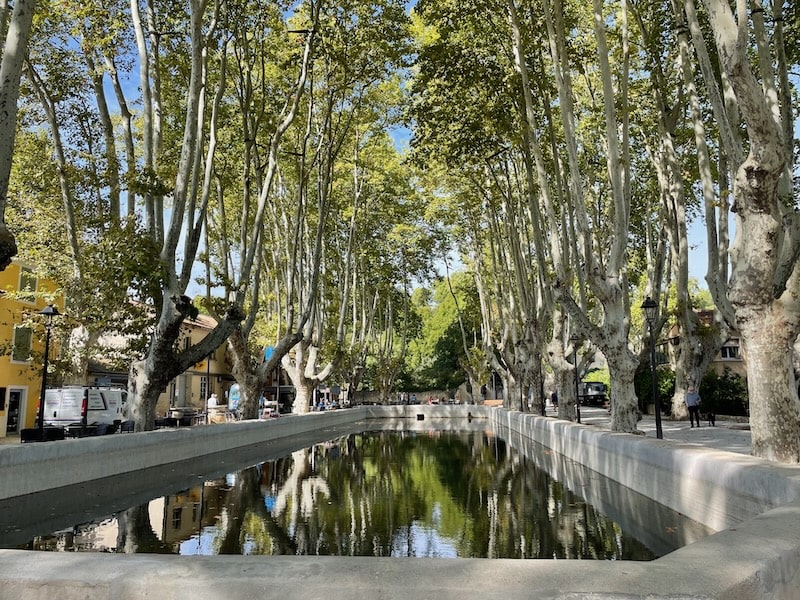
Cucuron is unusual in the Luberon for being built around water. At its heart lies the étang, a rectangular reservoir first dug in the Middle Ages to hold rainwater and used for irrigation. Today it is shaded by centuries-old plane trees and is the backdrop to the village’s Tuesday market.
The Gothic church of Notre-Dame-de-Beaulieu stands nearby, and archaeology shows occupation from the Neolithic through the Roman era, with traces of villas in the plain.
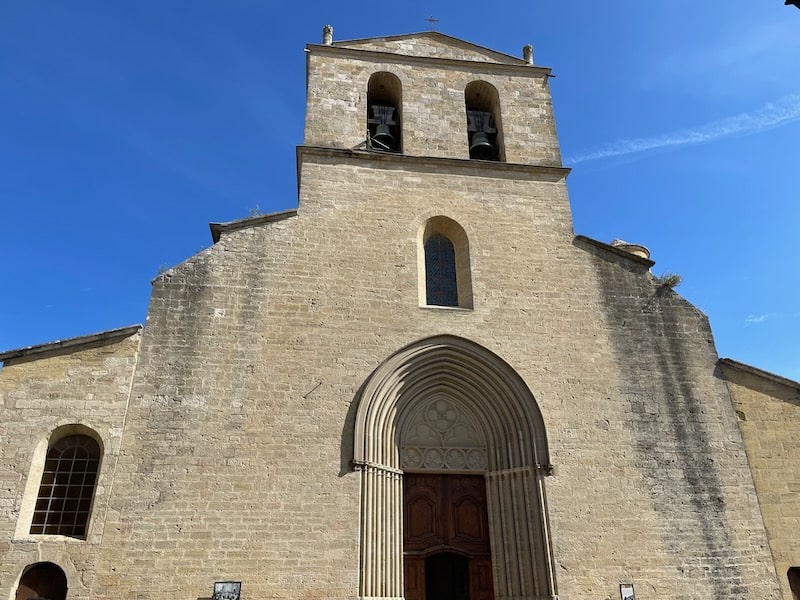

In the late Middle Ages Cucuron remained largely Catholic, unlike nearby Vaudois villages, a difference that spared it the destruction of the Wars of Religion.
Its name, derived from the Latin Cucurum, refers to the twin hills on which it was founded. You can still see the split layout as you wander between the lower market and the upper lanes near the Castellas.
An aside for film lovers: Ridley Scott used the étang for a key scene in A Good Year. Local rumor says the crew had to clear hundreds of frogs before filming to keep the sound levels down. (I sympathize: I have a pond invaded by mating frogs every spring!)
Cucuron feels more lived-in than many Luberon villages.
The étang isn’t just a photo op but part of daily life. Locals sit beneath the plane trees, children play near the water, and a few cafés frame the square (including an ice cream parlor and several highly rated restaurants).
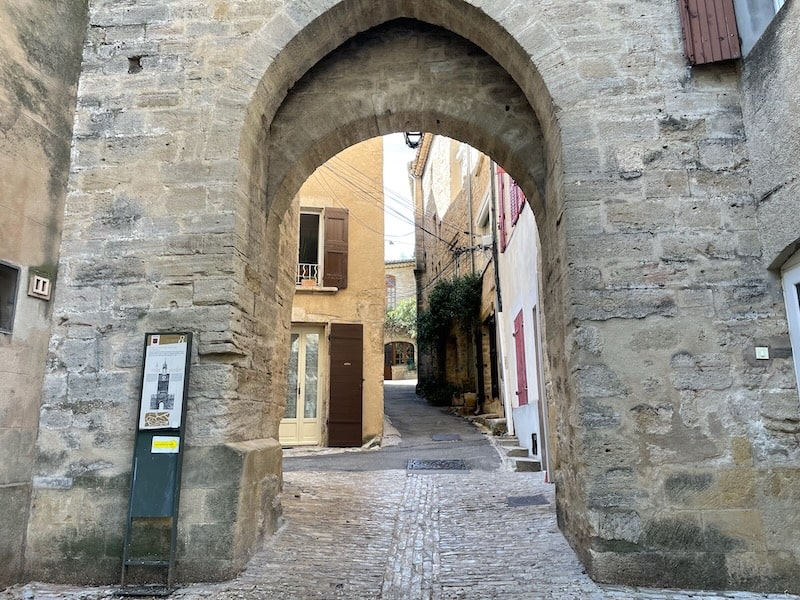
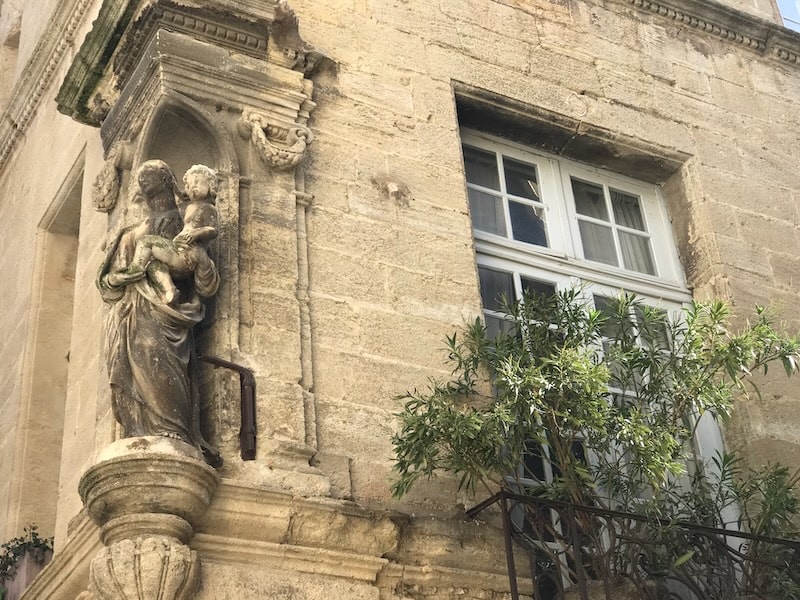
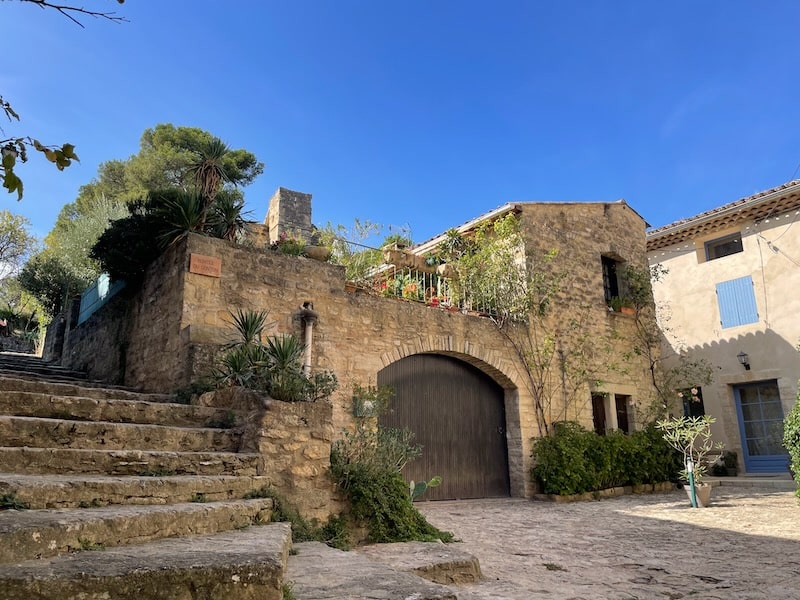
Cucuron still functions as a village, and despite the famous water feature, it hasn't quite become a tourist hotspot yet (but it's on its way). Stop for lunch at Restaurant de l’Étang or, if you’d rather stay overnight, Les Suites de l'Etang is right on the main square.
At the top of the village, the ruins of the Castellas tower remind you this was once a defensive site; on summer evenings, open-air concerts sometimes echo off its walls. And throughout the village you'll find signs in both French and English about the village's history and its main sights.
Beyond Cucuron, the road climbs toward the higher Luberon. Villages become smaller, and many are still not listed on regular Luberon itineraries.
FILM STOP
Fans of A Good Year can stand exactly where Russel Crowe sat, beside the water under the fourth plane tree on the west side of the étang.

6. Viens – fortified medieval character
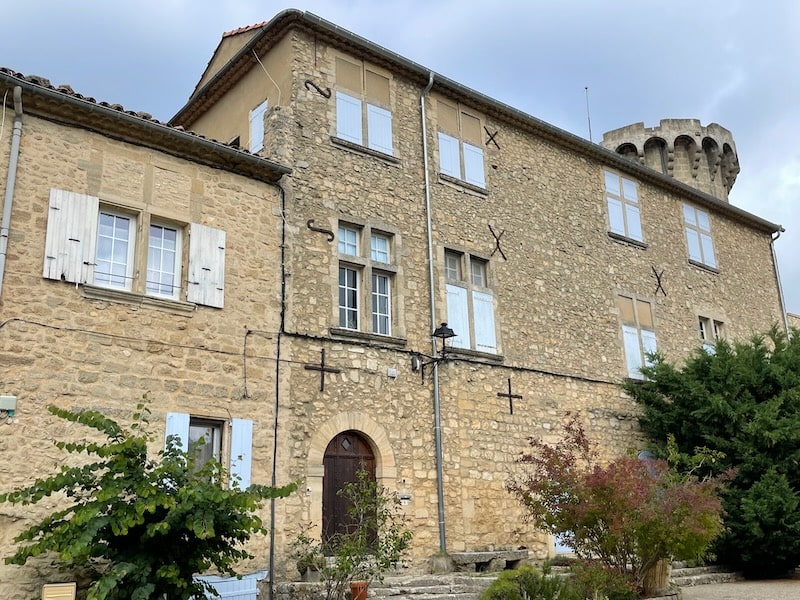
Viens is a fortified village on the eastern edge of the Luberon, a bit of a balcony overlooking the Calavon Valley.
The site has been inhabited since antiquity, with Roman remains found nearby, and the parish church was first recorded in 1005. In the Middle Ages, Viens belonged to the County of Forcalquier and later passed through the hands of several local noble families, including the Agoult and Simiane.
A small Jewish community lived here around 1300, one of several in the region.
It has kept much of its layout. The ramparts date from the 11th and 13th centuries, and remnants of towers, arches and vaulted passages line the narrow streets. Visitors still pass through the Porte de l’Horloge, a clock tower from 1720 built over an even older gateway, before reaching the small central square.

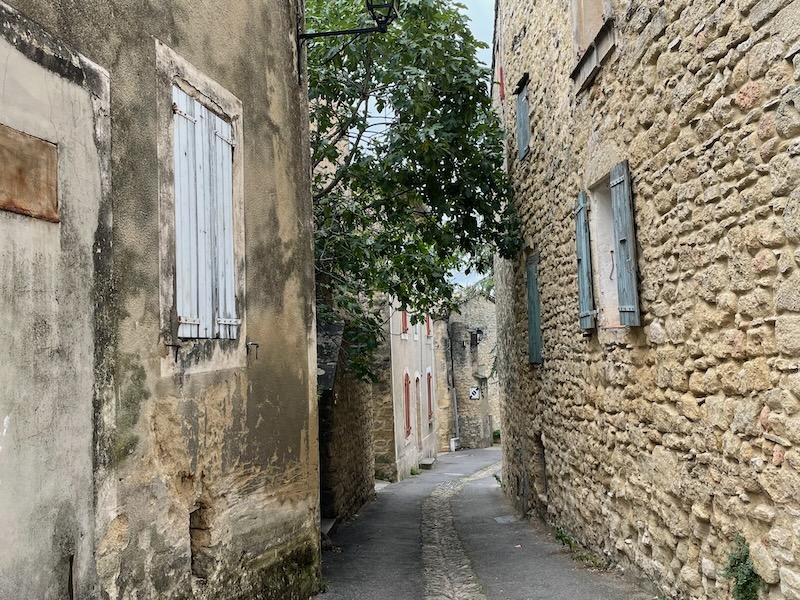
The original defensive wall enclosed the upper village, and you can still trace its line by following Rue du Four, where holes in the stone look down toward the plain.
From some angles Viens looks like a fortress, from others a simple hilltop village. Its views stretch across the Calavon Valley, and several walking paths start here toward the Plateau d’Albion.
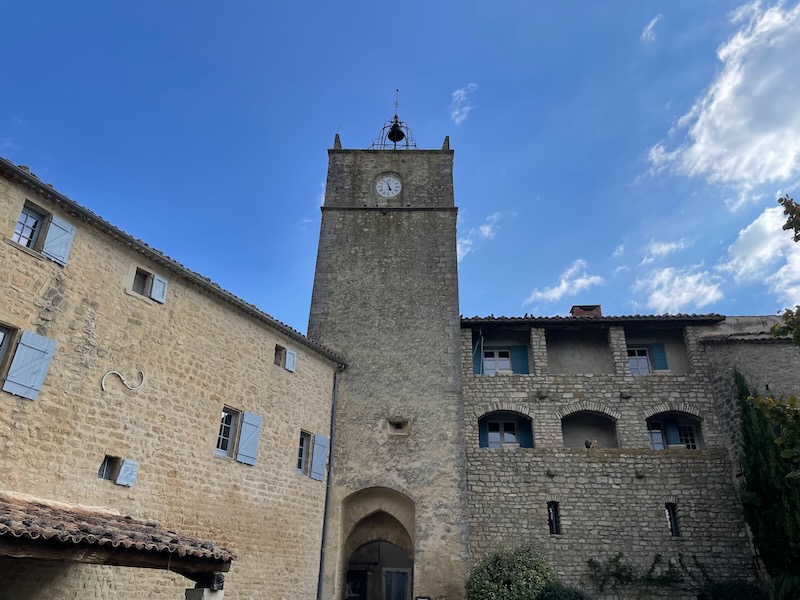

Like many Provençal villages, Viens lost much of its population after World War I, falling from about 1000 residents to just a few hundred.
Today, the village remains quiet and unhurried, with its calades (cobblestone strees lined with limestone stones along the edge, typical of the Luberon), stairways, and tiny post office giving it a lived-in charm.

When I stopped for lunch at Le Jardin, tucked behind the bar and tobacconist where locals buy their lottery tickets, the dining room (it's in the back and there's a terrace for summer) was full of conversation, with children running around and a dog or two for good measure. The daily dish was a perfectly acceptable (and copious) hachis parmentier, the French cousin of shepherd’s pie. All very local.
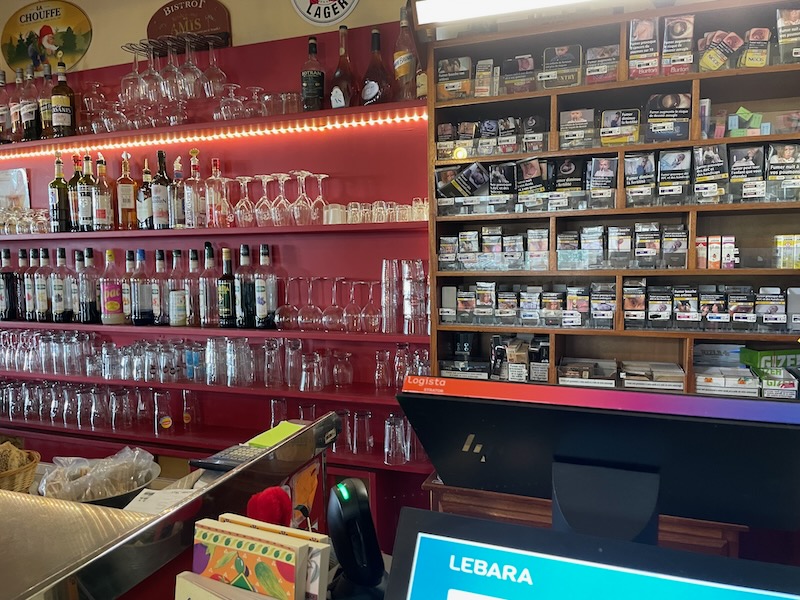 |
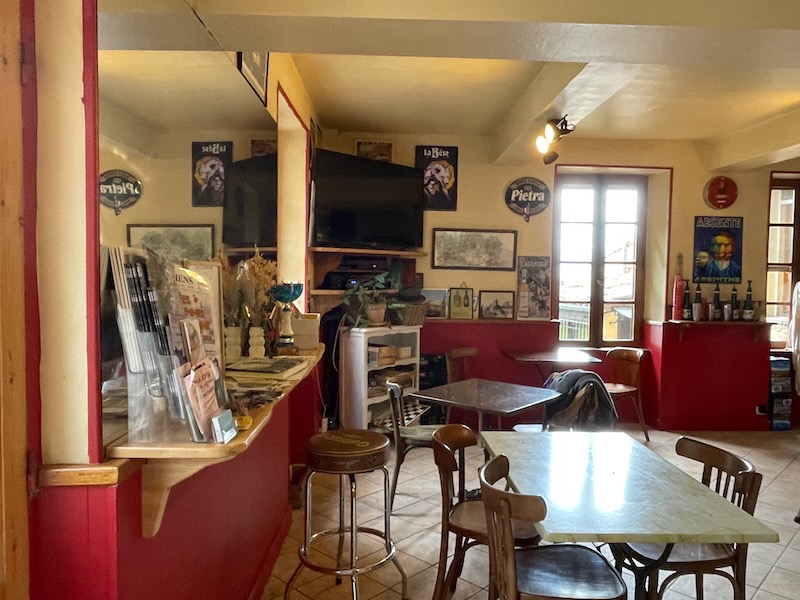 |
The GR4 long-distance trail cuts through Viens, a reminder that this was once a crossroads between the Alps and the Rhône. Hikers often stop for coffee at the bar before the long climb eastward.
If you linger, visit the pottery studio in Rue du Château, one of the few artisan workshops reputed still active year-round, proof that even tiny Viens has a creative streak.
A few kilometers west, Saint-Martin-de-Castillon shares the same lofty views but feels gentler – and is distinctly smaller.
TIP FOR WALKERS
From Viens, the GR4 leads toward Oppedette Gorge, one of the wildest canyons in Provence. Bring good shoes and water; it’s apparently a spectacular half-day walk (I say apparently because it isn't one I've tried).

7. Saint-Martin-de-Castillon
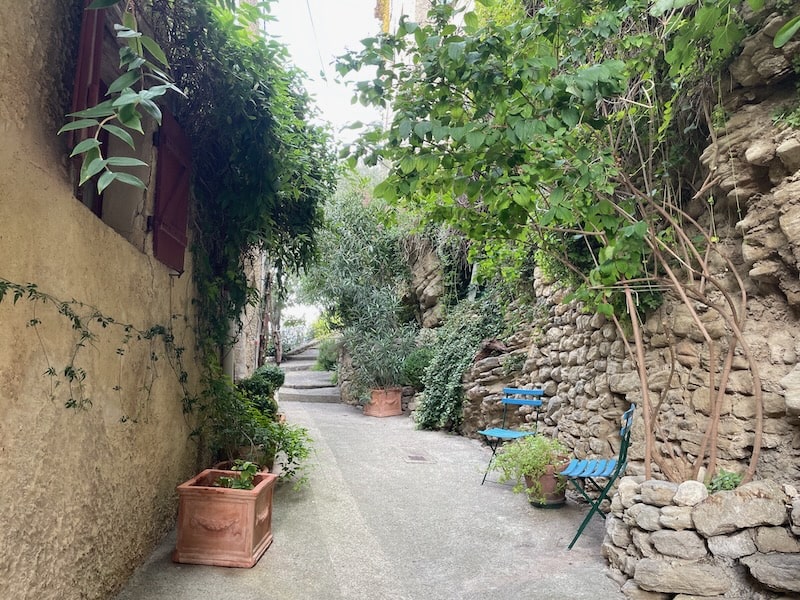
Saint-Martin-de-Castillon also perches above the Calavon Valley, its view stretching into the distance, its compact lanes built on a rocky spine that once anchored medieval defences.
The parish church, rebuilt in the 18th century over older foundations, marks the heart of this quiet place, with one café and a few artists’ workshops. The pace is slow even by Luberon standards.
In medieval times, two neighboring settlements stood here: Saint-Martin, owned by the Church of Apt, and Castillon, a fortified village of the Agoult family. Castillon was attacked in the 12th century and later destroyed during the Wars of Religion, after which residents settled permanently around Saint-Martin. The Great Plague of 1720 struck hard, but the village revived with vineyards and grain fields in the centuries that followed.
The current church, with its simple classical façade, still keeps the 18th-century bell that once warned of invasion and fire. You’ll hear it at noon, a single clear strike echoing across the valley. A lovely renovated chapel sits right next to the bar.

 Photo by Sébastien Thébault CC BY-SA 3.0
Photo by Sébastien Thébault CC BY-SA 3.0During World War II, Saint-Martin sheltered members of the Resistance, and a stone memorial recalls local poet Roger Bernard, executed in 1944.
He was part of René Char’s Maquis in nearby Céreste (another village worth seeing but I couldn't list them all!), and his death is remembered each June 22 with a brief ceremony on the roadside.
Today, a few artisans still keep workshops here, giving the village a quiet creative pulse.
If you arrive in spring, look for the small sign “Atelier Céramique – Ouvert quand j’y suis.” (Pottery workshop. Open when I'm there.) That’s the rhythm here. People open when they feel like it.


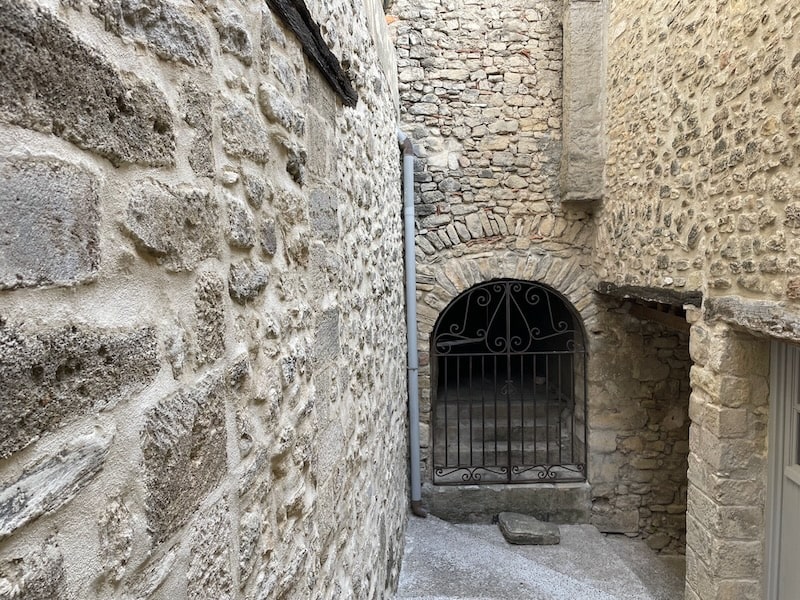
With just one café and a far-reaching view over the valley, it’s a small but enjoyable stop between Viens and Caseneuve.
CULTURAL NOTE
The “Fiélous” tradition, once banned for its bawdy humor, is being tentatively revived by local associations, part carnival, part heritage preservation.

8. Caseneuve – castle and views
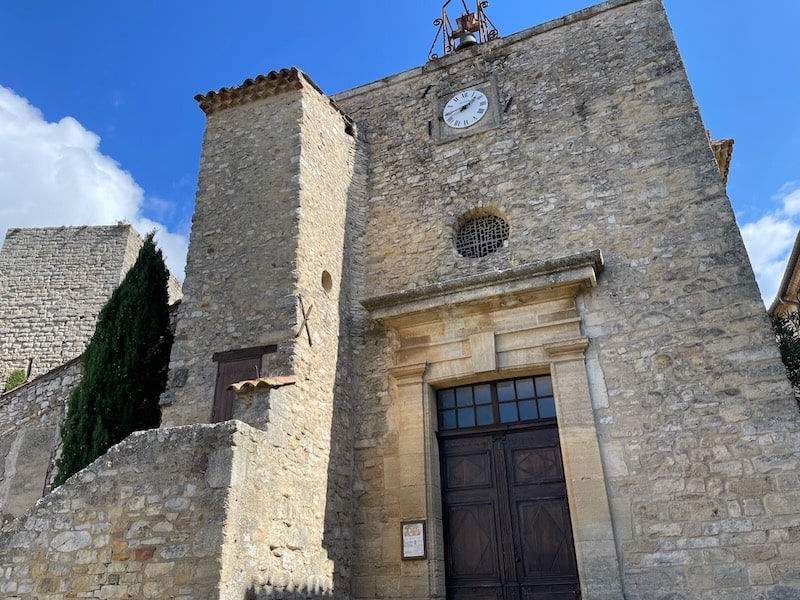
Caseneuve occupies a ridge east of Apt, dominated by its medieval château. The first castrum was built here in the 10th century under Humbert, ancestor of the powerful Agoult-Simiane family. The fortress that followed in the 12th century was later adapted as a residence and remains privately owned, though its tall tower and curtain walls still set the tone of the village.

Unlike many Provençal castles, this one never fell. Caseneuve was spared siege, spared plague, and survived the centuries almost unchanged — its towers keeping silent watch over the valleys of the Calavon and Dôa.
Caseneuve reads as a single contour line on a ridge: one street, stone packed tight around the château, and then nothing but air and view. At sunset, the light turns the stone pink and the valley gold — a scene that feels almost suspended outside time.
What makes Caseneuve distinct is its scale and isolation. It escaped the wars and plagues that ravaged nearby towns and even played a quiet role during World War II, when members of the local Resistance sheltered families here.
At its center stands the 17th-century church of Saint-Étienne, next to a small square with a fountain. The setting is wide open, with unobstructed views toward the Grand Luberon and Mont Ventoux, giving the place a sense of exposure unusual in this part of Provence.


The Oratoire Saint-Joseph, just beyond the village, offers another fine viewpoint across the valley.
The village’s association organizes guided walks in spring that connect Caseneuve, Viens, and Saint-Martin-de-Castillon, following ancient mule tracks once used for the olive oil and wool trade.
Caseneuve pairs well with Viens or Saint-Martin-de-Castillon if you're looking for a peaceful day exploring the lesser-known villages east of Apt.
VILLAGE WALK
Park below the mairie and climb to the château gate for the best views. On a clear day you can spot Mont Ventoux to the north and the Plateau d’Albion to the east.

A few practical points
- Most of these villages are small and quiet, with few cafés or shops, although those becoming more popular are developing new services each year. Just don’t expect souvenir stores or tourist offices on every corner — that’s part of their charm.
- A car is the easiest way to visit the Luberon and you can rent one on the edge of the Luberon in Caivaillon or Avignon. There are also a few options to visit the region without a car. That said, be aware that public transportation here is limited, though some can be reached by e-bike or local taxi from Apt.
- Parking is usually just outside the village walls, and you’ll walk uphill to reach the center, so make sure you bring water and wear shoes suitable for uneven cobblestones.
- In summer, mornings and late afternoons are best for wandering. The midday heat can be fierce, and many businesses close for lunch.
- Evenings are magical – the stone holds the day’s warmth, and you’ll often have entire streets to yourself once the day-trippers leave.
- These places stay peaceful year-round, but if you visit out of season, check opening hours for restaurants. In some villages, you may find only one place serving food, and that’s if you’re lucky.
FAQ
Which Luberon villages are the least touristy?
Which Luberon villages are the least touristy?
Among the quietest are Montjustin, Caseneuve, and Saint-Martin-de-Castillon, where few organized tours stop and visitor numbers remain low.
Can you visit these villages without a car?
Can you visit these villages without a car?
Public transport is very limited, and most of the smaller villages have no bus connections. A car is the most realistic way to reach them. However, if you're ready to do some legwork, you can see parts of the Luberon without a car. There are local buses to a few villages or you can rent an e-bike to get around.
How much time should you allow in each village?
How much time should you allow in each village?
Most can be visited in one to two hours. Larger ones like Cucuron or Céreste may take half a day if you also explore surrounding sites.
Are there restaurants or cafés in these villages?
Are there restaurants or cafés in these villages?
Some, like Cucuron, Goult and Ansouis, have a few places to eat, but others have none. It’s best to check in advance or plan meals in a larger town.
Before you go...
These smaller villages may not be as magnetic as Gordes or Roussillon, but they preserve much of the Luberon’s original character, its quieter side, stone lanes, hilltop views, and an authenticity that’s beginning to wane from some of the more famous names (but not all!)
If this is your first time in the Luberon and you'd like to at least see the highlights, here's a five-day Luberon itinerary that shows you how to combine the best loved destinations into easy day circuits.
Did you enjoy this article? I'd love if you shared it!


